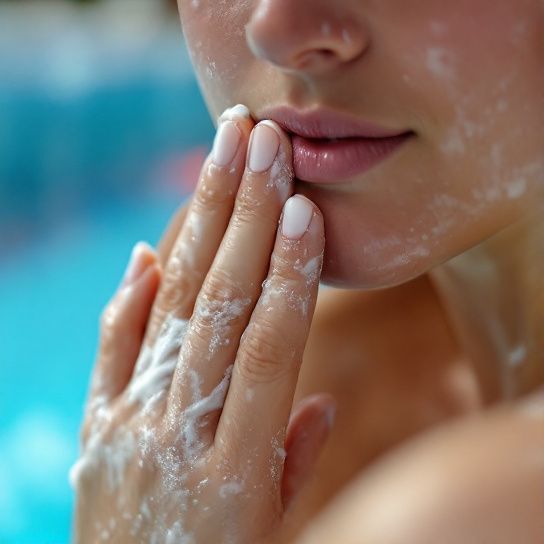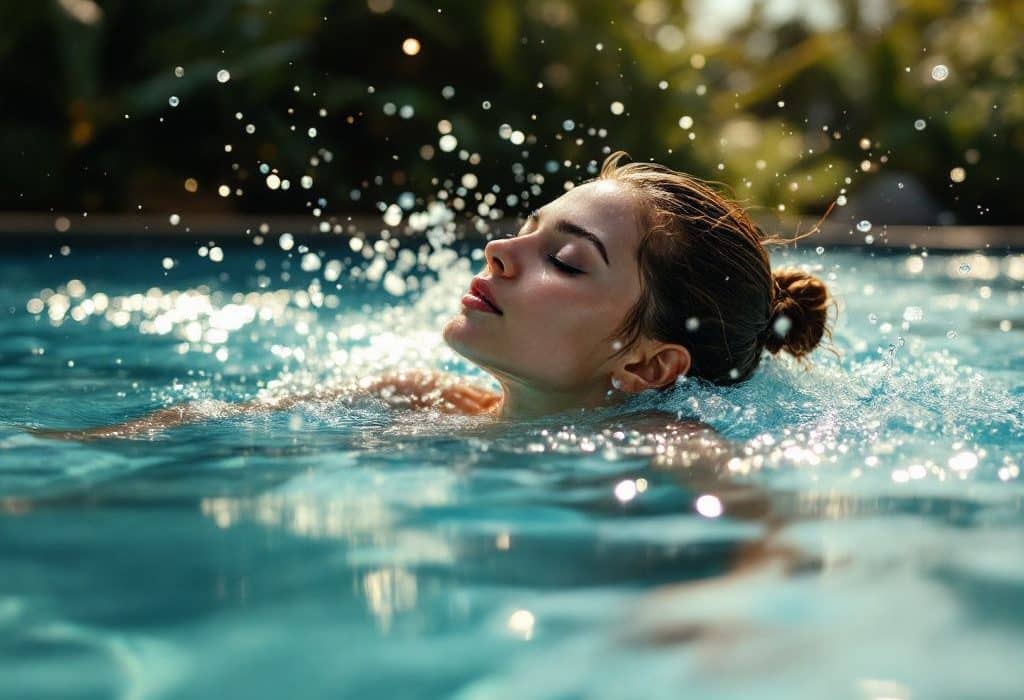Ever noticed how your skin feels after a long swim? Yeah, me too. It can feel tight, dry, a bit like an old leather handbag. You might even find yourself wondering: is spending all this time in the pool giving my swimmer skin an early retirement plan in the wrinkle department? If you’ve ever been concerned about how your aquatic habits might be impacting your skin’s longevity, well, sit tight because we’re diving deep (pun intended) into an anti-aging protocol that’s swimmer-friendly.
The Chlorine Challenge
So, first off, let’s address the elephant in the room: chlorine. You know, that tangy scent that sticks around long after you’ve left the pool? That’s because chlorine is tenacious. While it does a fantastic job of keeping pool water clean, it’s also a master at stripping moisture from your skin, leading to dryness and irritation. This lack of moisture is public enemy number one when it comes to aging—causing fine lines and even, god forbid, wrinkles.
Here’s the kicker: while chlorine isn’t going anywhere, how you manage your skin post-swim can make all the difference. How? Stay tuned, we’ll get there.
Pre-Swim Rituals You Shouldn’t Skip
Before you even touch the water, how about setting up some defenses against the harsh effects of chlorine?
1. Shower First
It’s tempting to skip the pre-swim rinse and jump straight into the pool, but this simple step can be a game-changer. A quick rinse with non-chlorinated water fills your skin’s pores so they’re less likely to soak up the pool water. Think of it like prepping your skin with a first layer of defense.
2. Barrier Creams
Next, let’s talk barrier creams. They’re more than just another product to clutter your bathroom counter. A good barrier cream can form a protective coat against chlorine, acting almost like a raincoat for your skin. Look for creams with natural oils or silicones—they’re great at fending off chlorine.

The Importance of Post-Swim Skin Care
So, you’ve done your swim. Now what? Post-swim care is just as vital, if not more. Here’s a straightforward routine you can rely on:
1. Rinse Immediately
Ever been tempted to linger poolside post-lap? Understandable, but here’s a nudge to put rinsing high on your priority list. Stripping off that chlorine as soon as possible minimizes prolonged exposure. That’s why many pools have rinse showers readily available. Use them!
2. Moisturize Ruthlessly
With your skin fresh and free from pool chemicals, it’s time to bring out the big guns—moisturizer. Choose one with ceramides or hyaluronic acid to lock in moisture. These ingredients work wonders in replenishing the moisture barrier that’s gotten a bit roughed up thanks to our friend chlorine.
3. Natural Oils
For those looking for something more natural, consider applying coconut or jojoba oil. They’re perfect for getting back that healthy glow and are mild enough if you’re concerned about specific skincare sensitivities.
Nutritional Terrains and Hydration
Let’s wander over to the wider picture—how internal factors impact your skin and can complement your anti-aging goals. Yeah, I’m talking food and drink.
1. Hydrate Like You Mean It
Sweating, moving, and exercising in the pool can lead to dehydration without proper water intake. And dehydrated skin? Don’t even get me started. It can appear cracked and wrinkly—a visual you’re likely not aiming for. Keep a water bottle within arm’s reach at all times.

2. Vitamin-Packed Diet
What goes into your body is just as impactful as what you put on your skin. Think antioxidant-rich foods—berries, spinach, nuts. Incorporating omega-3 fatty acids found in fish like salmon ensures your skin stays supple and radiant.
Regular Care and Maintenance
Taking stock of your skin’s condition periodically is just being savvy rather than wishful.
1. Gentle Exfoliation
Over time, dead cells can build up, leaving your skin looking dull. A gentle exfoliant once a week is enough to keep your face looking fresh. Just don’t overdo it—abrasive scrubs can do more harm than good, particularly for svelte swimmer skin.
2. Sunscreen: The All-Season Saviour
It doesn’t matter if your swimming routine is indoor or outdoor—sun protection is one of the most effective anti-aging strategies. Make sunscreen part of your daily ritual. After all, ultraviolet rays can penetrate glass windows too.
The Role of Consistency
Sure, we’ve listed a bunch of things you can do, but let’s be real—anything is better than doing nothing, even if you can’t do every step, every day. Just ensure a consistent skin-care routine overall, and your efforts will pay off. Plus, once it becomes part of your routine, it won’t feel like such a chore.
Common Pitfalls to Dodge
Don’t let convenience derail the progress you’re making.

1. Neglecting Neck and Hands
These areas are often left out in skincare routines, yet they show aging first and most noticeably. Trust me, a good slap of moisturizer on your neck and hands post-swim can do wonders.
2. All-in-One Products
They might save time, but products claiming they do everything aren’t always trusty. A good analogy? A Swiss army knife. Handy, for sure, but wouldn’t you rather have tools designed specifically for the job at hand?
Emotional and Social Well-being
Last but not least, tend to the ostensible—your well-being. Being joyful and stress-free radiates outwardly.
1. Finding a Community
Socializing in pool activities enhances both physical and emotional health. Classes, groups, or about-to-form clubs not only maintain your motivation but contribute significantly to feeling part of something bigger. That feeling can wax your glow brighter than any topical treatment or magic potion.
2. Mindfulness Practices
Adding a few minutes of meditation post-swim can help calm the mind and positively affect your overall well-being. In turn, improving how you feel inside will often reflect favourably outside.
Closing Thoughts
Swimming offers fantastic benefits, not just for fitness, but also for mental health and stress reduction. Yet, taking some straightforward actions toward maintaining healthy swimmer skin ensures that your skin will stay looking vibrant and radiant. Yes, it’s another thing to think about, but trust me on this one, it’s worth adding an extra step or two. Ultimately, these small changes and conscious actions can protect your skin and keep it luminous for the long haul, respecting the spirit and agility embedded in every refreshing lap.
Frequently Asked Questions
What is swimmer’s itch, and how is it caused?
Swimmer’s itch, also known as cercarial dermatitis, is a skin rash caused by an allergic reaction to the larval forms of parasitic flatworms (cercariae) released from aquatic snails. These parasites are typically found in fresh or salt water and mistakenly penetrate human skin, triggering an allergic reaction[1][3][5).
What are the symptoms of swimmer’s itch?
The symptoms of swimmer’s itch include an itchy rash that looks like pimples or blisters, often appearing on skin that was exposed to the contaminated water. The rash can also cause small blisters and may itch or burn. Symptoms usually begin within minutes to two days after exposure and can last for several days to up to two weeks[1][4][5).
How is swimmer’s itch treated, and can it be prevented?
Swimmer’s itch typically resolves on its own within a few days to a week without treatment. However, over-the-counter treatments can help relieve the itching. To prevent swimmer’s itch, choose swimming spots carefully, avoid areas near the shore where snails are common, and rinse and dry the skin thoroughly after swimming. Avoid feeding birds near swimming areas as well[1][4][5).
Is swimmer’s itch contagious, and who is most at risk?
Swimmer’s itch is not contagious from person to person. It is more common in individuals who spend time in water infested with the parasites, particularly young children who tend to wade and play in shallow water where the parasites are more likely to be found[1][4][5).
References- Cleveland Clinic. Swimmer’s Itch (Cercarial Dermatitis).
- Medical News Today. Swimmer’s itch: Symptoms, causes, treatment, and more.
- Mayo Clinic. Swimmer’s itch – Symptoms and causes.
- DermNet. Swimmer’s itch.



